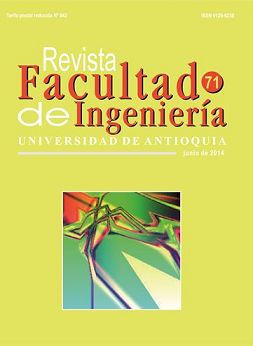Hydrostatic pressure and magnetic field effects on the energy structure of D- ion confined in a toroidal quantum ring
DOI:
https://doi.org/10.17533/udea.redin.16700Keywords:
quantum ring, energy spectrum, hydrostatic pressure, Wigner ́s crystal, ion D–Abstract
The energy structure of a ion, that is two electrons bound to a fixed donor impurity, imprisoned in a toroidal quantum ring is calculated as the full system is simultaneously under the presence of hydrostatic pressure probe and threading magnetic field. With the purpose of study the energy properties; we have assumed very narrow quantum rings which allow us to use the well-known adiabatic approximation in order to decouple the fast motion in radial and axial direction from the slow rotation motion. The changes of the energy level-ordering and the crossover among the curves as a function of center line radius, donor position, and magnetic field are calculated for different values of the hydrostatic pressure. Finally, we contrast the results with those previously reported for limit cases. From these comparisons it is possible to establish an excellent agreement among the different results which allow us to show the quality of the model implemented in the present work.
Downloads
References
J. Stang, V. Holy, G. Bauer. “Structural Properties of Self-Organized Semiconductor Nanostructures”. Review Modern Physics. Vol. 76. 2004. pp. 725-783. DOI: https://doi.org/10.1103/RevModPhys.76.725
L. Jacak, P. Hawrylak, A. Wójs. Quantum Dots. 1st ed. Ed. Springer. Germany, Berlin. 1997. pp. 5-12. DOI: https://doi.org/10.1007/978-3-642-72002-4_2
A. Lorke, R. Luyken, A. Govorov, J. Kotthaus, J. Garcia, P. Petroff. “Spectroscopy of Nanoscopic Semiconductor Rings”. Physical Review Letters. Vol. 84. 2000. pp. 2223-2227. DOI: https://doi.org/10.1103/PhysRevLett.84.2223
Y. Aharonov, D. Bohm. “Significance of Electromagnetic Potentials in the Quantum Theory”. Physical Review. Vol.115. 1959. pp. 485-491. DOI: https://doi.org/10.1103/PhysRev.115.485
T. Mano, T. Kuroda, S. Sanguinetti, T. Ochiai, T. Tateno, J. Kim, T. Noda, M. Kawabe, K. Sakoda, G. Kido, N. Koguchi. “Self-Assembly of Concentric Quantum Double Rings” Nano Letters. Vol. 5. 2005. pp. 425-428. DOI: https://doi.org/10.1021/nl048192+
G. Timp, A. Chang, J. Cunningham, T. Chang, P. Mankiewich, R. Behringer, R. Howard. “Observation of the Aharonov-Bohm Effect for ωcτ>1”. Physical Review Letters. Vol. 58. 1987. pp. 2814-2817. DOI: https://doi.org/10.1103/PhysRevLett.58.2814
N. Kleemans, I. Bominaar, V. Fomin, V. Gladilin, D. Granados, A. Taboada, J. García, P. Offermans, U. Zeitler, P. Christianen, J. Maan, J. Devreese, P. Koenraad. “Oscillatory Persistent Currents in Self-Assembled Quantum Rings”. Physical Review Letters. Vol. 99. 2007. pp. 146808-146811. DOI: https://doi.org/10.1103/PhysRevLett.99.146808
J. Planelles, J. Climente, F. Rajadell. “Quantum rings in tilted magnetic fields”. Physica E. Vol. 33. 2006. pp. 370-375. DOI: https://doi.org/10.1016/j.physe.2006.04.004
X. Wen. “A Two-Electron Quantum Ring Under Magnetic Fields”. Communications in Theoretical Physics. Vol. 49. 2008. pp. 1619-1623. DOI: https://doi.org/10.1088/0253-6102/49/6/58
F. García, J. Marín, H. Paredes, I. Mikhailov. “Low-lying states of two-electron quasi-one-dimensional ring”. Physics Status Solidi (c). Vol. 2. 2005. pp. 3630-3633. DOI: https://doi.org/10.1002/pssc.200461741
W. Xie. “Negative-donor centers and absorption spectra of quantum dots”. Journal of Physics: Condensed Matter. Vol. 20. 2008. pp. 365213-365217. DOI: https://doi.org/10.1088/0953-8984/20/36/365213
F. Betancur, W. Gutiérrez, J. Piña. “Energy spectrum of on-axis negatively charged donor in toroidal-shaped ring”. Physica B. Vol. 396.2007. pp. 12-15. DOI: https://doi.org/10.1016/j.physb.2007.02.003
I. Mikhailov, F. Betancur, R. Escorcia, J. Sierra. “Off-Center Neutral and Negatively Charged Donor Impurities in Semiconductor Heterostructures: Fractal Dimension Method, Off-Center Neutral and Negatively Charged Donor Impurities in Semiconductor Heterostructures: Fractal Dimension Method”. Physics Status Solidi (b). Vol. 234. 2002. pp. 590-610. DOI: https://doi.org/10.1002/1521-3951(200211)234:2<590::AID-PSSB590>3.0.CO;2-E
L. García, J. Marín, I. Mikhailov. “Negatively Charged Donors in Flat Quantum Dots”. Brazilian Journal Of Physics. Vol. 36B. 2006. pp. 878-881. DOI: https://doi.org/10.1590/S0103-97332006000600021
S. Huant, S. Najda, B. Etienne. “Two-dimensional D- centers”. Physical Review Letters. Vol. 65. 1990. pp. 1486-1489. DOI: https://doi.org/10.1103/PhysRevLett.65.1486
F. Betancur, I. Mikhailov, J. Marín, L. Oliveira. “Electronic Structure of Donor-Impurity Complexes in Quantum Wells” Journal of Physics: Condensed Matter. Vol. 10. 1998. pp. 7283-7293. DOI: https://doi.org/10.1088/0953-8984/10/32/019
E. Reyes, N. Raigoza, L. Oliveira. “Effects of Hydrostatic Pressure and Aluminum Concentration on the Conduction-electron g Factor in GaAs-(Ga,Al) As Quantum Wells Under in-Plane magnetic fields”. Physics Review B. Vol. 77. 2008. pp. 115308-115313.
J. Zhu, Z. Dai, X. Hu. “Two Electrons in One-Dimensional Nanorings: Exact Solutions and interaction energies”. Physical Review B. Vol. 68. 2003. pp. 045324-045331. DOI: https://doi.org/10.1103/PhysRevB.68.045324
Downloads
Published
How to Cite
Issue
Section
License
Copyright (c) 2018 Revista Facultad de Ingeniería

This work is licensed under a Creative Commons Attribution-NonCommercial-ShareAlike 4.0 International License.
Revista Facultad de Ingeniería, Universidad de Antioquia is licensed under the Creative Commons Attribution BY-NC-SA 4.0 license. https://creativecommons.org/licenses/by-nc-sa/4.0/deed.en
You are free to:
Share — copy and redistribute the material in any medium or format
Adapt — remix, transform, and build upon the material
Under the following terms:
Attribution — You must give appropriate credit, provide a link to the license, and indicate if changes were made. You may do so in any reasonable manner, but not in any way that suggests the licensor endorses you or your use.
NonCommercial — You may not use the material for commercial purposes.
ShareAlike — If you remix, transform, or build upon the material, you must distribute your contributions under the same license as the original.
The material published in the journal can be distributed, copied and exhibited by third parties if the respective credits are given to the journal. No commercial benefit can be obtained and derivative works must be under the same license terms as the original work.










 Twitter
Twitter